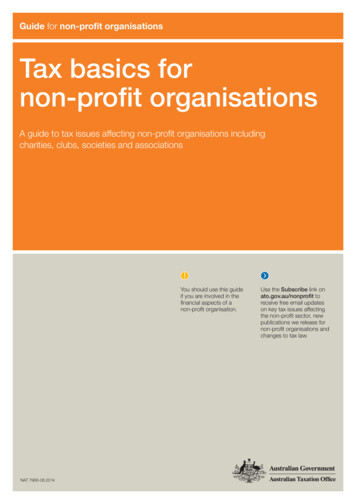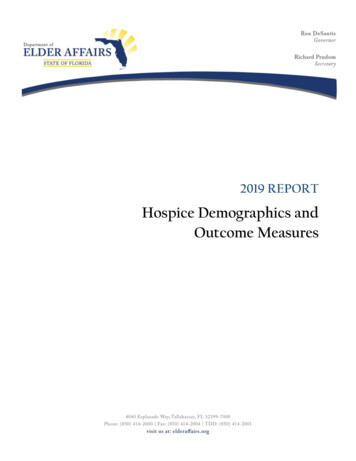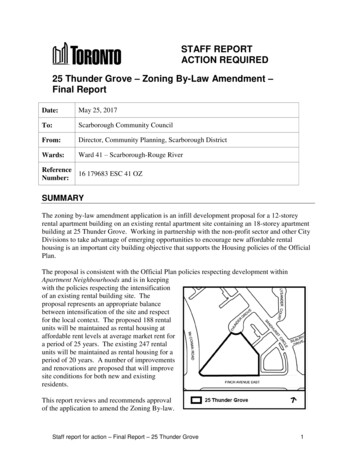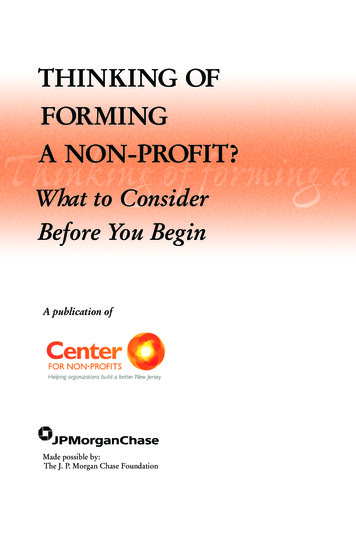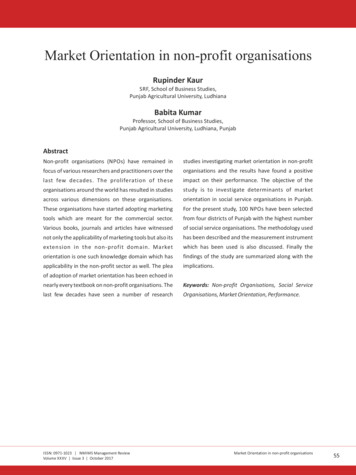
Transcription
Market Orientation in non-profit organisationsRupinder KaurSRF, School of Business Studies,Punjab Agricultural University, LudhianaBabita KumarProfessor, School of Business Studies,Punjab Agricultural University, Ludhiana, PunjabAbstractNon-profit organisations (NPOs) have remained instudies investigating market orientation in non-profitfocus of various researchers and practitioners over theorganisations and the results have found a positivelast few decades. The proliferation of theseimpact on their performance. The objective of theorganisations around the world has resulted in studiesstudy is to investigate determinants of marketacross various dimensions on these organisations.orientation in social service organisations in Punjab.These organisations have started adopting marketingFor the present study, 100 NPOs have been selectedtools which are meant for the commercial sector.from four districts of Punjab with the highest numberVarious books, journals and articles have witnessedof social service organisations. The methodology usednot only the applicability of marketing tools but also itshas been described and the measurement instrumentextension in the non-profit domain. Marketwhich has been used is also discussed. Finally theorientation is one such knowledge domain which hasfindings of the study are summarized along with theapplicability in the non-profit sector as well. The pleaimplications.of adoption of market orientation has been echoed innearly every textbook on non-profit organisations. TheKeywords: Non-profit Organisations, Social Servicelast few decades have seen a number of researchOrganisations, Market Orientation, Performance.ISSN: 0971-1023 NMIMS Management ReviewVolume XXXV Issue 3 October 2017Market Orientation in non-profit organisations55
IntroductionVazquez, Alvarez & Santos, 2002; Gainer & Padanyi,Non-Profit Organisations (NPOs) remain in constant2002; Kara, Spillan & DeShields, 2004; Shoham, Ruvio,focus of various practitioners and scholars. The use ofGadot & Schwabsky, 2006). Non-Profit Organisationsmarketing in the non-profit sector began in the latehave gradually become aware of the benefits of1960s and has accelerated in recent years; this has alsomarket orientation and have redesigned theirbeen widely acknowledged and practiced. Marketingstrategies accordingly to cope with the demanding andin Non-Profit Organisations differs from marketing inevolving environments (Shoham, Ruvio, Gadot &commercial organisations. There is a wide range ofSchwabsky, 2006). Researchers have made a numbermarketing strategies and instruments available to non-of contributions on operationalisation of the marketprofits that can be put into practice without changingorientation concept and more importantly, toor refuting their true mission (Dolnicar & Lazarevski,investigate its link with organisational performance.2009). In Non-Profit Organisations, marketing56strategies help to attract and allocate resources.1.5.1 Definition of Market OrientationThough marketing activities help NPOs in a number ofOn the basis of review of the literature on marketways, these are perceived as detrimental and tooorientation, it becomes apparent that numerousexpensive. This attitude still exists in Non-Profitdefinitions exist by different researchers to provide aOrganisations (Tscheulin & Helmig, 1998). Kotler anddefinitional accuracy and hypothetical background. AllLevi (1969) believe that marketing plays a very vitaldefinitions necessitate an external focus with therole in the activities of Non-Profit Organisations. It wascustomers as the primary focal point. All theargued that the non-profit sector faces market-likedefinitions except that of Deshpande & Webster,problems such as membership decline, funds crunch(1989) have given a clear idea of being responsive toand fierce competition. To deal with these issues, it hascustomers. Shapiro, 1988 has emphasized on thebeen suggested that marketing can help thesedecision making process, Kohli & Jaworski, 1990 on theorganisations to survive, grow and strengthen. Overinformation processing activities, Narver and Slater,the last decades, Non-Profit Organisations have1990 on the business culture as a set of behaviouralstarted adopting marketing tools with the realizationcomponents, Deshpande & Webster in 1989 on thethat it may help the organisation in achieving itsbusiness culture as a set of beliefs and Day, 2000mission.emphasized on organisational skills.Market orientation is one such marketing tool that hasAmong these researchers, the work of Kohli & Jaworskiapplicability in Non-Profit Organisations. Empiricaland Narver & Slater has been found to be significant instudies on Non-Profit Organisations over the lastpromoting the concept of market orientation and itsdecades indicate that NPOs must integrate marketfurther exploration by other researchers. Marketorientation into their key segments which includesorientation first appeared in the 1960s andcustomer orientation, competitor orientation, inter-experienced a revival in 1980s with the studies offunctional coordination and responsiveness. VariousShapiro (1988), Deshpande & Webster (1989), Kohli,researchers and practitioners have indicated renewedJaworski and Kumar (1990), Kohli, Jaworski & Kumarinterest in studying the concept of market orientation(1993) and Narver and Slater (1990). These studiesin the non-profit domain (Wood, Bhuian & Kiecker,incited a renewed interest amongst scholars to study2000; Balabanis, Stables and Philips, 1997; Kumar,the concept of market orientation. Kohli and JaworskiSubramanian & Strandholm, 1998; Voss & Voss, 2000;(1990) and Narver and Slater (1990) were the first toISSN: 0971-1023 NMIMS Management ReviewVolume XXXV Issue 3 October 2017Market Orientation in non-profit organisations
measure market orientation and to improve itssuperior value creation for the customers and thusunderstanding. With time, other researchers tried tosuperior business performance. They developedget deeper insights into the concept of marketMARKOR scale which consists of five behaviouralorientation and its relationship with firm performance,components - customer orientation, competitorinnovation, learning organisation andorientation, inter-functional coordination, long termentrepreneurship (Hurley & Hult, 1998; Slater &focus and profit focus.Narver, 1995).Over the years, numerous scholars have adopted the1.5.2 Measurement Scales of market orientationconceptualization and measurement approach givenWith the variety of definitions of market orientationby Narver and Slater. As a matter of fact, the twocome a multitude of scales for measuring theresearch streams share similar underlying postulationsconstruct. The measurement scales of Narver & Slater,(Homburg & Pfleser, 2000; Gebhardt, Carpenter &1990 (MKTOR scale) and Kohli & Jaworski (MARKORSherry, 2006). Although there is a lack of agreement onscale) have been widely used, either in the originalthe formal definition of market orientation, theform or adapted form.general construct of market orientation includescustomer orientation, competitor orientation andMKTOR Scaleinnovation (product) orientation.Kohli & Jaworski (1990) provided the behaviouralconcept and presented market orientation as a onedimensional construct with three components inMKTOR scale to measure market orientation. The firstcomponent “Generating Market Information” is basedon customers' needs and environment factors; thesecond component “Dissemination of Information”across different departments of the organisation, andthird, organisation wide “Responsiveness” includesplanning and implementation of marketingMONPO ScaleConsidering the need of market orientation in NonProfit Organisations and to measure it, MARKOR andMKTOR scales were adapted for NPOs. The MONPOscale was developed by Modi in 2012 to measuremarket orientation of NPOs. The scale includes 14items distributed among four factors: Donororientation, Inter-Functional Coordination, Peerorientation and Beneficiary Orientation.programmes. Many scholars have adopted thisdefinition given by Kohli and Jaworski because of theintuitive logic and ease with which market orientationcan be measured.Donor OrientationNon-Profit Organisations attract various resourcesfrom donors for allocation among beneficiaries. NPOsmust create an environment where a mutuallyMARKOR Scalesatisfying exchange can be maintained with the donorsUnder MARKOR scale, twenty items are included in(Balabanis, Staples & Philips, 1997). Thesethree components: Intelligence Generation,o rga n i s at i o n s m u st att ra c t re s o u rc e s f ro mIntelligence Dissemination and Responsiveness ofgovernment, corporates, institutions and individualmarket. The second perspective of market orientationd o n o rs , a s w i t h t h e g ro w t h o f N o n - P ro f i twhich also held a strong footing in the marketingOrganisations, the task of resource attraction hasliterature is given by Narver and Slater in 1990. Theybecome difficult. Donor orientation states that theconceptualized market orientation as culture thatorganisation must be sensitive and responsive towardscreates necessary behaviours for the creation ofthe needs and expectations of the donors. TheISSN: 0971-1023 NMIMS Management ReviewVolume XXXV Issue 3 October 2017Market Orientation in non-profit organisations57
organisation must communicate to the donors anddiversity in the goals and the objectives pursued bymust be accountable. Donor orientation is the focus ofthese organisations. Padanayi & Gainer (2004);the organisation on the current and potential donors,Balabanis, Staples and Philips, (1997) in their studiesand communicating and meeting them regularlyhave defined various measures of performance. They(Modi & Mishra, 2010).have used two judgmental measures to measure theperformance of non-profit organisations. Gainer &Peer OrientationPadanayi (2005) have used client satisfaction asResearchers are of the view that an organisationorganisational performance measure.should know the strengths and weaknesses of the keycurrent and future competitors (Narver and SlaterLiterature Review1990). Gallagher and Weinberg (1991) have opinedThis section deals with the review of scholarly work onthat NPOs compete for donors' resources and usethe market orientation concept and its link tothem to develop more valuable offers than the optionso r g a n i s a t i o n a l p e r fo r m a n c e i n n o n - p r o f i tavailable with competition. However, competition inorganisations. Studies on market orientation of non-the non-profit domain is non-threatening and isprofit organisations are limited in number with a fewcollaborative in nature wherein organisations shareconceptual and few empirical.their resources and capabilities to better serve thebeneficiaries (Huxham & Vangen, 1996; Rothschild,Carter (1992) examined the relationship between1999). Modi & Mishra (2010) have conceptualizedmarketing and societal orientation in the non-profitpeer orientation as the organisational focus oncontext. The author proposed a conceptual model tounderstanding peers' strengths, weaknesses andl i n k m a r ket i n g a n d s o c i eta l o r i e ntat i o n tostrategies, and collaborating with them can help toorganisational learning theory. In the model, it wasbetter serve beneficiaries.asserted that market orientation has an impact ondonors and beneficiaries. The author discussedBeneficiary Orientationvarious philosophies and practices which determinedModi & Mishra, 2010 have defined beneficiarythat organisational learning helps in market andorientation as the organisational focus onsocietal orientation. The philosophy of marketunderstanding the explicit and latent needs oforientation can be linked to various learning sub-beneficiaries, designing services to meet those needssystems in the organisation. The author determinedand regularly monitoring beneficiary satisfaction.that organisational learning is related to marketBruce (1995) has discussed that NPOs lose sight of theorientation.beneficiaries in certain conditions as theseorganisations work in monopolies but they shouldA working paper by Dwyer (1993) determined that thehave proper understanding of beneficiary needs sonon-profit sector is becoming more competitive andthat they can be served better. Non-profits shoulddue to various reasons, NPOs are forced to performprovide such services which are best suited to theefficiently and effectively. In response to this, NPOsbeneficiaries.have to become market oriented. The components ofmarket orientation, market segmentation and58Performance and Effectivenesscustomer-oriented products which are suitable for for-The performance of non-profit organisations isprofits are also well suited in the context of NPOs. Thedifficult to define and measure as there is a vastpaper asserted that three factors- management,ISSN: 0971-1023 NMIMS Management ReviewVolume XXXV Issue 3 October 2017Market Orientation in non-profit organisations
scarcity of resources and conflict between marketprofessional ethics and organisationalorientation and organisational objectives are majorentrepreneurship, and three environmental factors.contributors for the adoption of market orientedThe study also finds the relationship between marketculture by NPOs.orientation and hospital performance, and revealedthat there is a positive association between marketBalabanis, Staples and Philips (1997) studied theorientation and professional commitment, anddegree of adoption of the marketing concept byorganisational entrepreneurship and hospitalcharity organisations and its effect on theirperformance.performance. The survival of charity organisations isheavily dependent on the success in the donor market.Liao, Foreman, Sargeant (2001), in a conceptual paper,An increase in the number of charities has resulted inhave argued that there is a need to develop a separateintense competition for donations. In response toconceptualization and measure of the marketthese pressures, charities are adopting marketingorientation concept in non-profit organisations. Inconcepts and are becoming market oriented. TheSpanish non-profit foundations, Vazquez, Alvarez andauthors tried to measure the effect of donor marketSantos et al (2002) have found that adoption of theorientation on the attainment of long term (five years)market orientation concept has resulted in betterand short term (annual) objectives of the organisation.organisational performance. According to Gonzalez,MARKOR 20-item scale adapted to the donors' marketVije and Casielles (2002), the concept of marketcondition was developed. The study revealed that theorientation of NPOs includes six components -level of donor-market orientation is low. It wasbeneficiary orientation, donor orientation, competitorobserved that larger organisations were reluctant toorientation, environment orientation, integration andbecome market oriented. The study revealed thatinternal coordination, and adoption of long-termdonor-market orientation has no impact on themanagement perspective. The researchers however,performance of charities.do not provide a measure for the conceptualization ofthe market orientation concept in NPOs.Brady and Johnson (2000), in a conceptual paper, havepresented theoretical and observationalHarrison & Shaw (2004) explained market orientationmeaningfulness of market orientation. The aim of theand marketing culture of the staff of the organisationstudy was to develop an appropriateto find the extent to which members create barriers orconceptualization of market orientation for non-profitsupport the market oriented culture within theorganisations. The study highlighted that there is a lackorganisation. The research was conducted to know theof a unified understanding of market orientation androle of not-for-profit organisations which are oftenthere is a need to develop rigorous measures of marketthought of as having no marketing focus. The authorsorientation.argued that there may be behavioural and culturalconflicts within the organisation. The findings indicateWood, Bhuian and Kiecker (2000) conducted a study tothat all areas in the organisation are committed tofind antecedents and consequences of marketmarket orientation.orientation in 237 not-for-profit hospitals. The studyrevealed a positive relationship between marketMacedo & Pinho (2006) studied the concept of marketorientation and four organisational factors, namely,orientation in the context of the non-profit sector. Inprofessional commitment, professional education,the increasingly demanding resource environment,ISSN: 0971-1023 NMIMS Management ReviewVolume XXXV Issue 3 October 2017Market Orientation in non-profit organisations59
non-profits have to adopt the concept of marketing aswider spectrum of stakeholders such as donors,a strategy with a view that it will help the organisationvolunteers, staff members and beneficiaries. In ato receive resources from the environment for thenutshell, authors suggested that increased learningrealization of its mission. The article tried toactivities will definitely lead to market orientation andinvestigate the type of revenue strategy suitable to theimproved business performance.organisation's market orientation towards donorsand/or users. The findings from a quantitative study ofHsieh, Curtis & Smith (2008) presented a paper ona representative sample of Portuguese non-profitmarket orientation and implications of stakeholders'organisations (N P Os) revealed that resourceconcept in non-profit organisations. The authorsdependence theory is very critical to understand theargued that market orientation is rooted inmarket orientation in NPOs. The study determinedstakeholders' environment. Sustainability of anthat resource strategies and market orientation of anorganisation depends upon the competence to alignorganisation are interlinked. The study also revealedstrategic behaviour with stakeholders' interest. Thethat resource diversification strategies favour a highauthors suggested that executives of Non-Profitdegree of market orientation of the organisation.Organisations need to explore new opportunities toattend to the under-served stakeholders' networks.Shoham, Ruvio, Gadot & Schwabsky (2006) examinedAccording to the authors, Arts Organisations cannotthe concept of marketing in voluntary non-profitsustain on one single stream of resource fromorganisations by investigating the market orientationcustomers. They need to develop orientations towardconcept. NPOs are in the process of learning anddifferent stakeholders.implementing various ideas and methods which havebeen followed by various for-profit organisations. ItIn India, Modi and Mishra (2010) sampled 211 non-was found that conceptualizations of marketprofit organisations and found a positive link betweenorientation are not easy to implement in the not-for-market orientation and organisational performance.profit sector. Authors determined that marketModi (2012) has proposed an alternativeorientation is a key driver of organisationalconceptualization of market orientation (namedperformance.MONPO) which is applicable to NPOs operating inIndia.Carter (2007) asserted that market orientation has60been widely researched to find its relationship withHashim and Bakar (2011) studied customer-definedorganisational performance of for-profit as well as not-market orientation (CDMA) and results of non-profitfor-profit organisations. There is a need to understandorganisations. With the number of non-profitthe various organisational barriers to completelyorganisations increasing, getting financial support,realize the concept of market orientation. The barriersvolunteers and employees is becoming increasinglycan take various forms such as barriers of structure anddifficult. External conditions force these organisationssystem, people related barriers, etc. The authorsto define and refine their strategies and missions.suggested that firms can learn faster by creating a newAccording to authors, to sustain their existence, NGOslearning culture and learning routines which willneed to be market oriented. The authors developed aultimately lead to gaining competitive advantage. Theconceptual model in which CDMA is placed as aauthors determined that increased activities ofprecursor of service quality (SQ) and customerlearning routines may lead to the involvement of asatisfaction (C S). The study investigated theISSN: 0971-1023 NMIMS Management ReviewVolume XXXV Issue 3 October 2017Market Orientation in non-profit organisations
relationship between CDMA-SQ-CS. The authorspeculiarities of the functioning of these organisations.determined that organisational culture influences thebehaviour in the organisation and suggested thatThe relationship of market orientation withthere is a positive association between customer-organisational performancedefined market orientation and service quality.The impact of market orientation on organisationalperformance has been studied extensively for the for-Mahmoud & Yusif (2012) examined the impact of theprofit sector in many countries and acrossadoption of market and learning orientations on theperspectives. However, the impact of MO onperformance of non-profit organisations. NPOs areorganisational performance has been under-facing the challenge of continuous change whichresearched. Some of the empirical studies conductedforces them to implement various organisationalin NPOs have been discussed in this section. Amongchange models. The authors studied the inter-different studies undertaken in the non-profit sector,relationship between market orientation, learningthe impact of market orientation on organisationalorientation and economic and non-economicperformance has assumed importance in theperformance of the organisation. It was found thatmarketing literature (Caruana, Ramasheshan, Ewing,there is a statistically significant relationship between1997; Kumar, Subramanian & Strandholm, 1998;performance and market orientation, but learningWood, Bhuian and Kiecker, 2000). In most of theorientation has an immense impact on thestudies conducted in non-profit organisations, it wasperformance.found that there is a positive relationship betweenmarket orientation and organisational performanceModi (2012) operationalised it as a second-orderlike fundraising performance (Kara, Spillan andconstruct consisting of four equally important first-DeShields, 2004), increased attendance (Voss & Voss,order components - beneficiary orientation, donor2000) and growth in resources and reputationorientation, peer orientation as an equivalent of(Padanyi & Gainer, 2004). Various empirical studiescompetitor orientation, and inter-functionalhave been conducted in a variety of organisationscoordination, and prepared a preliminary scale of 21including universities (Caruana, Ramaseshan & Ewing,items using exploratory methods. A study was1998; Flavian & Lozano, 2006), cultural organisationsconducted on 579 NPOs delivering community service(Gainer & Padanyi 2002; Voss & Voss, 2000), hospitalsto prepare a valid and versatile scale to study market(Wood, Bhuian and Kiecker, 2000) and charitiesorientation of non-profit organisations in India. Finally(Balabanis, Stables, Philips, 1997; Bennett, 1998; Kara,a 14-statement scale was developed which isSpillan and DeShields, 2004; Macedo & Pinho 2004;applicable to NPOs in India. A validated confirmatoryMorris, Coombes, Schindehritte & Allen, 2007;scale was developed which can be used by non-profitVazquez, Alvarez and Santos, 2002). All these studiesorganisations to study their market orientation. Thehave been conducted in the western context andMONPO scale is only 14 items long which offers thefound to have a positive relationship between marketbenefits of efficiency and parsimony. The items in thisorientation and organisational performance, exceptscale are such which the practitioners in an emergingVoss &Voss (2000).economy like India would find relevant, easy tounderstand and applicable. The scale named MONPOBalabanis, Staples and Philips (1997) examined UKhas certain advantages over other scales as it wascharity organisations where the correlation coefficientdeveloped from scratch by considering theof market orientation and organisational performanceISSN: 0971-1023 NMIMS Management ReviewVolume XXXV Issue 3 October 2017Market Orientation in non-profit organisations61
was 0.41. Caruana, Ramaseshan & Ewing (1997)orientation in 191 private not-for-profits in Spain. Thestudied the Australian public sector and found thatauthors have asserted that market orientation has athere exists an average correlation of .36 betweenpositive impact on beneficiaries and monetarymarket orientation and organisational performance ofresources. They used operationalisation by Kohli andthe organisations.Jowarski (1990) and reported a correlation coefficientof 0.32.Caruana, Ramaseshan & Ewing (1998b) studiedmarket orientation of Australian universities andGainer & Padanyi (2002) examined the impact ofpublic sector organisations. The authors foundmarket orientation on organisational performance incorrelation coefficients of 0.60 and 0.52 between453 social service, community support and artmarket orientation and public sector performance.organisations. The study revealed that client activitiesand culture were positively related to organisationalBennett (1999) examined small UK charities by usingperformance. The study found that there exists anproprietary MO operationalisation and reported aaverage correlation of .22 between market orientationcorrelation coefficient of 0.24 between marketand organisational performance of the organisations.orientation and organisational performance (fundraising success). Caruana, Ramaseshan & Ewing (1999)Pinho & Macedo (2002) studied the relationshipexamined the relationship between marketbetween market orientation and organisationalorientation and organisational performance in 171performance in Portuguese and asserted that marketAustralian public sector entities. The study found aorientation enhances organisational performance butpositive correlation coefficient of 0.61 betweenprovided no further details.market orientation and organisational performance.Padanyi & Gainer (2004) studied market orientationVoss & Voss (2000) examined the relationship betweenand culture on one hand, and improvement inmarket orientation and organisational performance incustomer satisfaction on the other hand, in 599 social134 theatre artistic organisations. They reported non-service, community support and art organisations insignificant correlation coefficient of 0.02. Wood,Toronto and Montreal. The study revealed that marketBhuian & Kiecker in 2000 studied 237 not-for-profit-orientation activities affect the organisationalhospitals in US and the correlation coefficientperformance indirectly.between market orientation and organisationalperformance was found to be non-significant (0.08).The review has revealed certain gaps in the literatureon market orientation in non-profit organisations. TheCervera, Molla & Sanchez (2001) studied marketreview has also revealed that there is a lack oforientation, its antecedents and performance in 177agreement over the scales used for the measurementSpanish public sector organisations. The study usedof market orientation. First, most of the past studiesoperationalisation by Kohli and Jowarski (1990) andconducted by various researchers have used thetwo sets of performance indicators - global and citizenadapted versions of MARKOR scale developed by Kohliparticipation; the correlation coefficients were 0.35and Jaworski (1990). Some authors (Oczkowski &and 0.40 for two sets.Farrell, 1998) have argued that this scale is narrowlyfocused on information generation and dissemination,Vazquez, Alvarez and Santos (2002) studied market62ISSN: 0971-1023 NMIMS Management ReviewVolume XXXV Issue 3 October 2017and does not consider the notion of stakeholders. OnMarket Orientation in non-profit organisations
the other hand, the scale MAKTOR developed by34,436 NPOs. These NPOs are registered under TheNarver and Slater has gained applicability in the for-Societies Act, 1860, The Charitable and Religious Trustsprofit context. Various researchers have used theAct, 1920, The Indian Trusts Act and The Indianadapted version of this scale to study marketCompanies Act, 1956. A list of NPOs was obtainedorientation and its various dimensions in thefrom Office of Economic Adviser, Government ofcommercial sector. But in the non-profit context, therePunjab, Chandigarh. As per the survey report byis a need to conceptualize the MAKTOR versions. ModiEconomic Advisor, Government of Punjab, 2012,and Mishra (2010) have argued the conceptualizations51.06% NPOs are working under the social serviceof Narver and Slater have better applicability in non-category. As social service organisations constitute aprofits. Secondly, most of the previous empiricalmajor share in the number of total Non-Profitstudies have found the link between marketOrganisations, the present study has focused on socialorientation and performance in developed countries.service organisations only. In Punjab, 4 Districts -The very first study in a developing country like IndiaGurdaspur 13.30%, Ludhiana 12.86%, Muktsar 12.13%has been conducted by Modi and Mishra in (2008) byand Sangrur 10.62% have the highest number of NPOsusing the Narver and Slater conceptualization in 211in the social service sector i.e. 48.91% of total NPOs. Anon-profits and found a link between marketlist of NPOs in the social service sector in these fourorientation and organisational performance.districts was prepared. Out of this list, a sample of 100NPOs (25 in each district) was selected using simpleNon-profit organisations are under increased pressurerandom sampling.to prove that they are achieving their missionseffectively and efficiently
authored a monograph in International Finance. Dr. Malindretos is professor of Finance at the Cotsakos College of Business as well as the co-editor of The International Journal of Finance Journal of and the Business in Developing Nations. He can be reached at malindretosj@wpunj.edu. ISSN: 0971-1023 NMIMS Management Review
